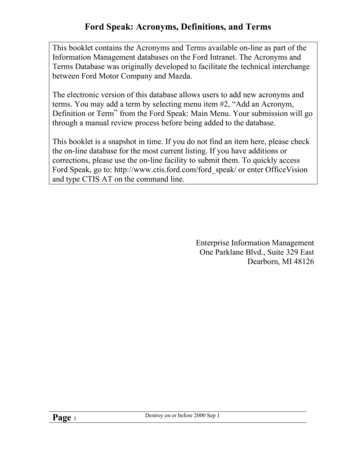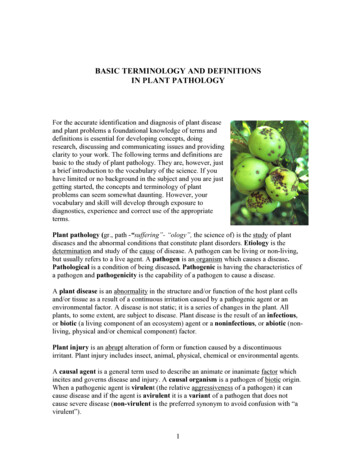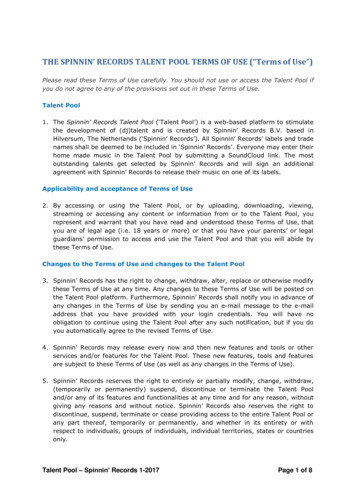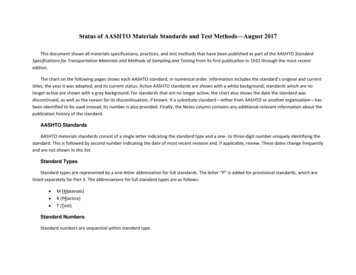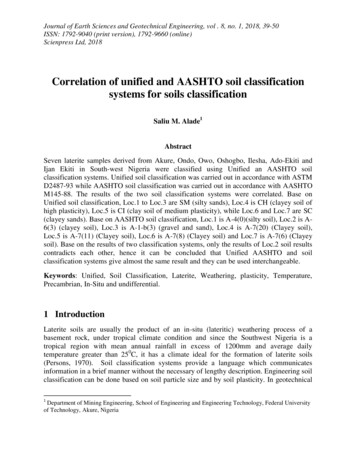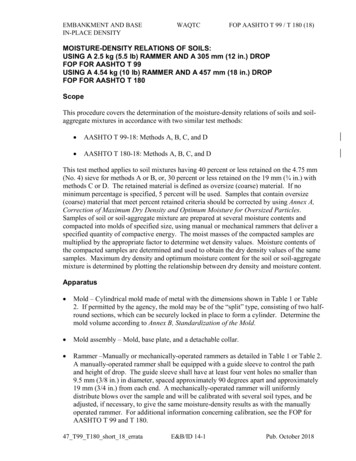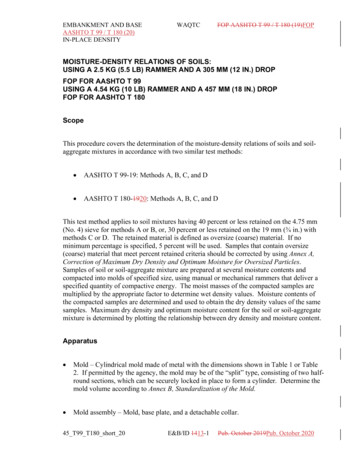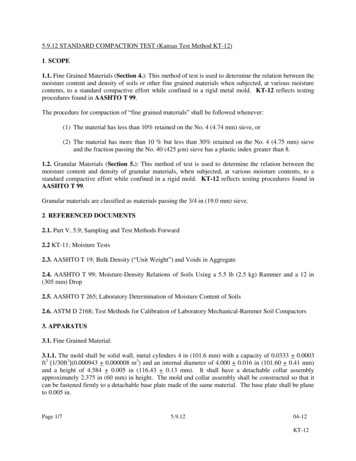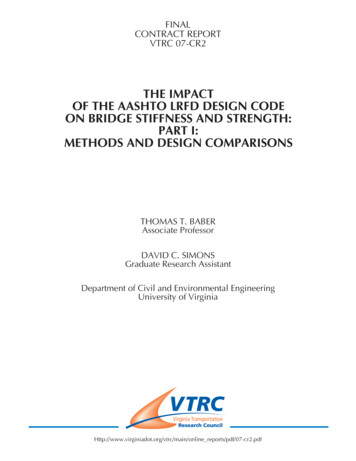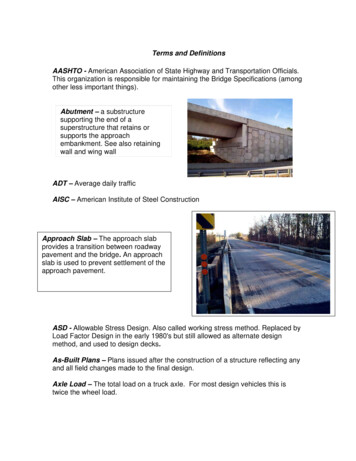
Transcription
Terms and DefinitionsAASHTO - American Association of State Highway and Transportation Officials.This organization is responsible for maintaining the Bridge Specifications (amongother less important things).Abutment – a substructuresupporting the end of asuperstructure that retains orsupports the approachembankment. See also retainingwall and wing wallADT – Average daily trafficAISC – American Institute of Steel ConstructionApproach Slab – The approach slabprovides a transition between roadwaypavement and the bridge. An approachslab is used to prevent settlement of theapproach pavement.ASD - Allowable Stress Design. Also called working stress method. Replaced byLoad Factor Design in the early 1980's but still allowed as alternate designmethod, and used to design decks.As-Built Plans – Plans issued after the construction of a structure reflecting anyand all field changes made to the final design.Axle Load – The total load on a truck axle. For most design vehicles this istwice the wheel load.
Backfill – Retained fill as in the regionbehind an abutment backwall andbeneath the approach. This viewshows the strips attached to an REwall.Backwall – The topmost portion ofan abutment above the elevation ofthe bridge seat that functions as aretaining wall with a live-loadsurcharge or as a support for thebridge deck and the approach slab.In this case, the wall is an RE wall.Batter Pile – A pile which isinclined in order to resist largelateral loads.
Beam – A horizontal membersupporting vertical loadsBeam Seat – refers to the surface onwhich a bearing rests.
Bearing Pad – A pad consisting of layers ofsynthetic rubber and steel plates that supportsbridge members and transmits the loads from thesuperstructure to the substructure. They allowdeflections due to longitudinal expansion of thebridge and vertical deflection of the beams. Seealso Elastomeric Pad. Other bearing types areplate bearings (below left) and rocker bearings(below right).Bent - A substructure unitsupporting the superstructure.It is usually a frame consistingof a cap, columns andfootings
Berm – A shelf or level region in front ofthe cap on an end bent.BFI - Bridge Foundation Investigation. The geotechnical lab's report telling us the type offoundation (pile type or spread footing) and the capacities of the piles (or soil), based onanalysis of soil survey.BFPR - Back Face PavingRest. This marks thebeginning and ending pointsof the bridge, located at theinterface of the end bent andthe paving rest. See alsopaving rest.
Box Culvert – A culvertmade out of a reinforcedconcrete box structure.Box Girder – A superstructure designwhich utilizes a box-shaped trunkproviding good torsional rigidity.Brace –A structural memberwhich is placed diagonally inorder to provide stiffness to aframe.
Bulb Tee - A prestressedbeam shape developed inthe 1990's with a wide topflange (the "tee") and acompact bottom flange (the"bulb"). It comes in 54", 63",and 72" standard sizes.caissondeep foundation - a type of foundationdistinguished from shallow foundations by thedepth they are embedded into the ground.There are many reasons a geotechnicalengineer would recommend a deep foundationover a shallow foundation, but some of thecommon reasons are very large design loads, apoor soil at shallow depth, or site constraints(like property lines). There are different termsused to describe different types of deepfoundations including the pile (which isanalogous to a pole), the pier (which isanalogous to a column), drilled shafts, andcaissons. Piles are generally driven into theground in situ; other deep foundations aretypically put in place using excavation anddrilling. The naming conventions may varybetween engineering disciplines and firms.Deep foundations can be made out of timber,steel, reinforced concrete and prestressedconcrete.Rebar cage for caisson
Cap - The top of a bent, itsupports the bridge beamsand behaves like acontinuous beam.Cap Step - a level part of a capthat supports a beam. Beams atdifferent elevations will sit on capsteps of different elevations.Cast-in-place – Refers to concrete which ispoured and cured in its final location in thefield. This is a caisson poured in place withthe rebar extending out to tie to the columns.
Chamfer - a diagonally cut off corner of ashape. Rectangular concrete sections havechamfers so the corner won't crack off andlook irregular. Compare with fillet.Cheekwall – A concrete wall,typically joined to anabutment wingwall used toshield pedestals, bearings,and stringer ends.Coping - the concrete between the top of the beam and the bottom of the slab. The depth ofcoping varies along the length of the beam to account for differences between roadway gradealong the beam and the grade of the top of the beam. See D DimensionCrash Wall - A wall constructedfor the protection of the RR whenhorizontal clearance is notachieved
Cover – The distance between the exposed surface of a concrete element and thetopmost surface of the reinforcing steel.Cross Frame – Steel elements,comprised of crossing, steelangles which are placed in an“x” configuration to act asdiaphragms.Culvert – A structure throughwhich runoff flows. See alsoBox Culvert.Curved Girder – Agirder which is curvedin the horizontal planeto accommodate theoverpass horizontalalignment.
D Dimension - The distance fromthe top of slab to the top of beamover the bearing. It includes theslab and the coping.Deck Drain - A hole formed in the deck at the face of barrier to drain water. Not used overroadway travel lanes, end fills, railroad right of way, or closer than 5 feet to a bent. NOTused on a high side of a superelevated bridge.Development Length - The length of rebar required to provide enough bond with thesurrounding concrete to develop full tension capacity of the rebar. See AASHTODFD - Distribution Factor for Deflection. Total number of wheel lines divided by number ofbeams.DFM - Distribution Factor for Moment. How live load is distributed to beams acting in unison.See AASHTO Table 3.2.3.1DFV - Distribution Factor for Shear. Maximum number of wheel lines that will distribute to abeam based on simple spans between beams. This is important near the ends of bridge wherethere isn't much deflection and on exterior beams.
Diaphragm - A concrete or steelstiffening member placedtransversely in a span to providelateral stability for beams andmake the beams act in unison inresisting live loads.Dowel Bar - Any short round bar, but typically it refers to the steel dowel barformed into a cap, extending through a hole in the bearing pad, and into a chasein the bottom of the beam to hold the beam in place.Effective Width – In composite construction, the width of a concrete slab whichfunctions as the top flange of a composite T-section.Edge Beam - A concrete stiffeningmember placed transversely at theend of a span to provide additionaldeck support at the discontinuity in adeck at the centerline of the bent.Embedment Length - The length ofrebar required to provide enough bondwith the surrounding concrete toprovide any usable tensile strength inthe bar. See AASHTO
Elastomeric Pad –A pad made of layers ofsynthetic rubber and steelplates which compressesunder loads. The two platesin the top and bottom arecalled load platesSeeBearing Pad.Embankment – A raised area of fill surrounding a structural component.Embedment Length – Thelength of rebar required tobond with the surroundingconcrete in order to providethe necessary tensilestrength to resist themoment in the member
End Bent - The bent at theend of the bridge, consisting ofcap, wingwalls, and piles. Alsosometimes called anabutment, though really anabutment consists of theembankment as well as theend bent.Endpost - A structure at theend of a bridge barrier orparapet that the guard rail isconnected to. See Ga. Std.3054.Expansion Joint - A joint allowing expansion. Their width is dependent on the amountof movement they are to accommodate. Deck joints are always maintenance problems.Fall Line - A geologic discontinuity in GA runningfrom Augusta to Columbus defining the boundarybetween the Piedmont Region and the CoastalPlan. Metamorphic (gneisses and schists) andplutonic igneous rocks (ex: granite) can be foundabove the fall line. South of the line, only sedimentsand sedimentary rocks are present, comprisingGeorgia’s Coastal Plain. It is called the Fall Linebecause the first falls or rapids in riversencountered as one comes inland from the oceanare usually found at this boundary. The fall line forbridge design is loosely based on this line. Bridgedecks north of this line are given additional coverover the top layer of reinforcement as protectionfrom salts used in de-icing. See Design Memos,chapter 4.Fall Line in Butts County
Falsework – A temporary supportstructure made of steel or wood.Typically used for formwork or erection ofa structural member.Fascia Beam - When a multi-span bridge is in a visible area and beams ofdifferent spans have different depths, a fascia beam is sometimes used on theexterior of the shorter spans to match the deeper beams of the longer span.Fillet - (pronounced "fill-it") The additional material placed in the joint where twomembers come together. This is done to prevent a crack from forming along theinterface. Compare with chamfer.Filter Fabric - Plastic fabric placed underneath riprap to keep the underlying soilfrom eroding away.Fixed Support – A support designed to accommodate rotation only.Flange – The top and bottomhorizontal component in a girder
Footing – The base to a column or wall which transfers loads from thesubstructure to the subsoil.A floodplain or flood plain is a flat or nearly flat land adjacent a stream or river that stretchesfrom the banks of its channel to the base of the enclosing valley walls and experiences floodingduring periods of high discharge.
Form – A temporary structure which actsas a mold for a concrete element until theelement has the required strength tosupport itself, or metal deck forms whichare used to support the concrete untilcuring and are left in place afterwards.FPA - Future Paving Allowance. A load allowance that allows additional deckmaterial to be placed as the wearing surface needs to be repaired. 15 psf or 30 psf.Framing Plan – A plan view of the bridge used to show the layout, geometry andproperties of superstructure primary and secondary members.
Framing Plan – A plan view of the bridge used to show the layout, geometryand properties of superstructure primary and secondary members.Girder – commonly used to refer to a primary member placed along thelongitudinal axis of a bridge. Used interchangeably with the term stringer.Gravity retaining wall –Grooved Concrete - Shallow transverse cuts on a bridge deck that providebetter drainage and traction. Use of grooving is dependent on traffic countsand route status. See MOG.Group Loading - Combination of loads and forces (e.g., dead load with liveload, wind stream flow, etc.) that a structure must be able to withstand.Guard Rail -Hammerhead Pier – Used to describe the geometry of a pier with a capsimilar in shape to a hammer.Haunched Girder – Amember whose crosssectional depth varies fromsupport to support.Heave - The upward movement of soil which can be caused by moisture,excavation, pile driving, etc.Hooks - Rebars are bent at the end when the bar needs to develop in ashorter length than the development length.
Impact – A factor used to describe the dynamic effect of a vehicle movingacross a bridge.Inventory Rating – The load capacity of a bridge under normal serviceconditions (55% of yield strength)Jacking – The lifting of an element or group of elements using hydraulic orother types of jack and if needed, a temporary support system.Jersey Barrier – A concrete barrier named after the New Jersey DOT, whichfirst developed it. Also known as traffic barrier, median barrier andconcrete barrier.Lane Loading – A hypothetical design loading used to simulate a train oftrucks moving across the bridge.Live Load – A temporary, moving load such as vehicular trafficLoad Rating – A value indicating the load capacity of a bridgeLoad Plate - A steel plate in the top and bottom of a neoprene bearing padthat distributes the weight of a beam evenly over the entire bearing surface.(See elastomeric pad)Longitudinal – Used todescribe the axis of abridge which proceedsfrom abutment toLRFD - Load Resistance Factor Design. A new design method, not yet inabutment.use, using statistical models to determine load factor increases andstrength reductions. Currently we use LFD which is sort of a lite versionand predecessor of LRFD.Metal Deck Forms Corrugated galvanizedsteel stay-in-place deckforms that span betweenbeams and hold up the wetconcrete during a deckpour.MSE Wall
Military loading – A loading configuration used to simulate heavy militaryvehicles passing over a bridge.Negative Moment – Bending moment which causes tension in the top fiberand compression in the bottom fiber.Overlay – See wearing surfaceParapet – A concrete barrier.Typically refers to a barrier placedon the outside face of the bridgedeckPile casing-
Paving Rest - Part of theendwall on which theapproach slab rests.PDO - Plan Driving Objective. The required tip elevation of piles in afoundation and their design capacity. This comes directly from the BFI.Pier - A bridge substructureunit. See bent.Pile - A steel or concretemember driven into theground that providessupport for a bridge due tofriction with thesurrounding soil and endbearing of the tip on a hardsubsurface layer.
Pile Bent - A substructure unit consisting of a cap and piles only where apile is driven under each beam.PileGirderFootingPlate- - A footing supported on piles. Compare with spread footing.Posted Bridge -Post-Tensioning - When hardened concrete has external stresses applied toit to give it better performance under design loads. Usually consists ofsteel strands passing th
AASHTO - American Association of State Highway and Transportation Officials. This organization is responsible for maintaining the Bridge Specifications (among other less important things). Abutment – supporting the end of a superstructure that retains or supports the approach embankment. See also retaining wall and wing wall ADT – Average daily traffic AISC – American Institute of Steel .
